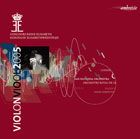Javier Torres Maldonado recently received an important recognition: A jury composed of Luis de Pablo, Tristan Murail, Kaija Saariaho, Ivan Fedele, Luca Francesconi, Michael Jarrell, Pascal Dusapin, Arie Van Elisabeth, Nicolas Bolens, Stefan Niculescu and Frederik van Rossum unanimously handed him the first prize in the composition section of the International Queen Elisabeth Contest in Brussels for his new work, Obscuro Etiantum Lumine, for violin and three orchestral groups. Obscuro Etiantum Lumine was chosen as the compulsory piece in the section dedicated to violinists in the same contest and was performed twelve times by the finalists and the Orchestre National de Belgique, conducted by Gilbert Varga at the Grande Salle of the Palais des Beaux-Arts in Brussels on May 23.
Obscuro Etiantum Lumine (Before dawn), composed last year, is clearly divided in four sections, each one dedicated to a specific “nocturnal” sonority: 1) Sub lumina prima – at the first candlelight 2) Luna plena (in numerum ludere) – Full moon (dancing to the rhythm of the melody) 3) Lumen Lucernae (cum luna laboret) – the light of a lantern (moon eclipse) 4) Cum sidera viderit innumerabilia cum eius ipsius (mundi) motu congruere – When you will see the uncountable stars moving in harmony with the sky itself.
The composer states: “Obscuro Etiantum Lumine springs from my profound friendship and admiration for Carlo Chiarappa. Despite my own past as a violinist, before I met Chiarappa my incursions into the violin repertoire had been sparse (Invención, for solo violin and Tres Estudios that actually are part of an unfinished project of a book of five studies), perhaps because when you know well the repertoire of an instrument with such an important history, whatever you try to compose seems almost redundant. It is thanks to Chiarappa that I came back to this idea and set to work on completing the book of etudes a few years ago besides writing other works for him (The unexpected clock in the mirrors, for solo violin and bass clarinet and ensemble of five players).
As in some other pieces of mine, the titles never should be considered suggestions of a “programmatic” interpretation; they are rather to be taken as ideas to suggest a type of lighting, to touch on a timbral characteristic or they are direct allusions to the poetic idea that helped me to settle on a determined technique of composition. A very important aspect of this piece is the spatialisation of the material, obtained by dividing the orchestra in three groups, creating stereo effects between similar instruments placed opposite each other. An important detail emerges from the observation of the instrumental setting: the total absence of the two violin sections. This characteristic reveals my strong intention of reorganizing the instrumental sounds and balance and it also underlines the importance of the role of the solo instrument”.
